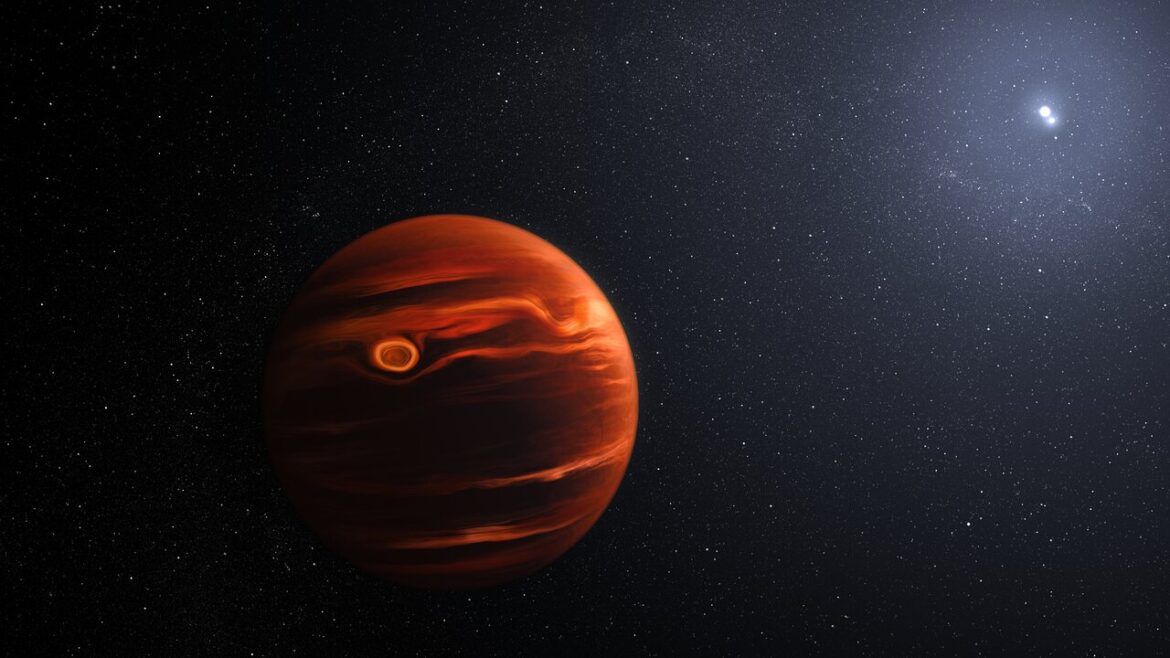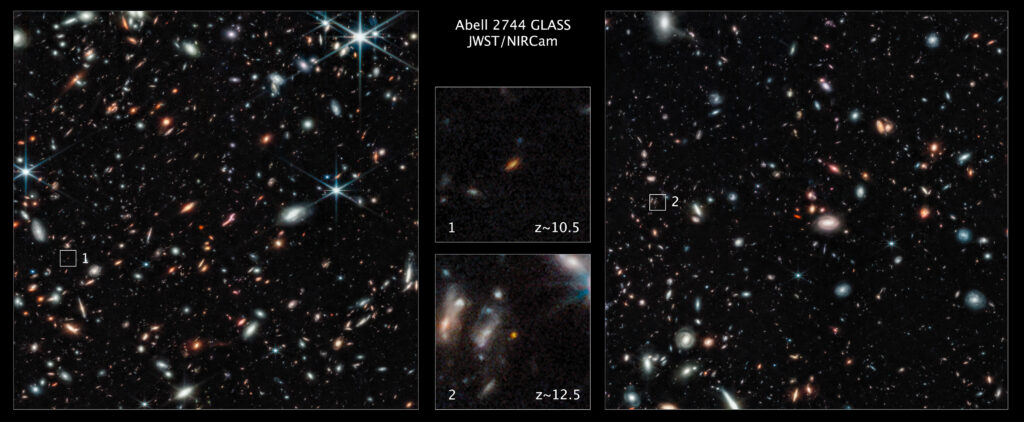Webb spots swirling, gritty clouds on VHS 1256 b, a remote planet
Researchers observing with the NASA/ESA/CSA James Webb Space Telescope have pinpointed silicate cloud features in a distant planet’s atmosphere. The atmosphere is constantly rising, mixing, and moving during its 22-hour day, bringing hotter material up and pushing colder material down. The resulting brightness changes are so dramatic that it is the most variable planetary-mass object known to date. The science team also made extraordinarily clear detections of water, methane and carbon monoxide with Webb’s data, and found evidence of carbon dioxide. This is the largest number of molecules ever identified all at once on a planet outside our Solar System.

Credit:
NASA, ESA, CSA, J. Olmsted (STScI)
Catalogued as VHS 1256 b, the planet is about 40 light-years away and orbits not one, but two stars over a 10 000-year period.
“VHS 1256 b is about four times farther from its stars than Pluto is from our Sun, which makes it a great target for Webb,” said science team lead Brittany Miles of the University of Arizona. “That means the planet’s light is not mixed with light from its stars.” Higher up in its atmosphere, where the silicate clouds are churning, temperatures reach a scorching 830 degrees Celsius.
Within those clouds, Webb detected both larger and smaller silicate dust grains, which are shown on a spectrum.
“The finer silicate grains in its atmosphere may be more like tiny particles in smoke,” noted co-author Beth Biller of the University of Edinburgh in the United Kingdom. “The larger grains might be more like very hot, very small sand particles.”
VHS 1256 b has low gravity compared to more massive brown dwarfs [1], which means that its silicate clouds can appear and remain higher in its atmosphere where Webb can detect them. Another reason its skies are so turbulent is the planet’s age. In astronomical terms, it’s quite young. Only 150 million years have passed since it formed — and it will continue to change and cool over billions of years.

Credit:
NASA, ESA, CSA, J. Olmsted (STScI), B. Miles (University of Arizona), S. Hinkley (University of Exeter), B. Biller (University of Edinburgh), A. Skemer (University of California, Santa Cruz)
In many ways, the team considers these findings to be the first ‘coins’ pulled out of a spectrum that researchers view as a treasure chest of data. In many ways, they’ve only begun identifying its contents.
“We’ve identified silicates, but a better understanding of which grain sizes and shapes match specific types of clouds is going to take a lot of additional work,” Miles said. “This is not the final word on this planet — it is the beginning of a large-scale modelling effort to fit Webb’s complex data.”
Although all of the features the team observed have been spotted on other planets elsewhere in the Milky Way by other telescopes, other research teams typically identified only one at a time.
“No other telescope has identified so many features at once for a single target,” said co-author Andrew Skemer of the University of California, Santa Cruz. “We’re seeing a lot of molecules in a single spectrum from Webb that detail the planet’s dynamic cloud and weather systems.”
The team came to these conclusions by analysing data known as spectra gathered by two instruments aboard Webb, the Near-Infrared Spectrograph (NIRSpec) and the Mid-Infrared Instrument (MIRI). Since the planet orbits at such a great distance from its stars, the researchers were able to observe it directly, rather than using the transit technique [2] or a coronagraph [3] to take this data.
There will be plenty more to learn about VHS 1256 b in the months and years to come as this team — and others — continue to sift through Webb’s high-resolution infrared data. “There’s a huge return on a very modest amount of telescope time,” Biller added. “With only a few hours of observations, we have what feels like unending potential for additional discoveries.”
What might become of this planet billions of years from now? Since it’s so far from its stars, it will become colder over time, and its skies may transition from cloudy to clear.
The researchers observed VHS 1256 b as part of Webb’s Early Release Science program, which is designed to help transform the astronomical community’s ability to characterise planets and the discs from which they form.
The team’s paper, entitled “The JWST Early Release Science Program for Direct Observations of Exoplanetary Systems II: A 1 to 20 Micron Spectrum of the Planetary-Mass Companion VHS 1256-1257 b,” will be published in The Astrophysical Journal Letters on 22 March.
Press release from ESA Webb.















